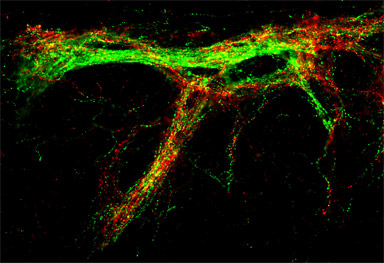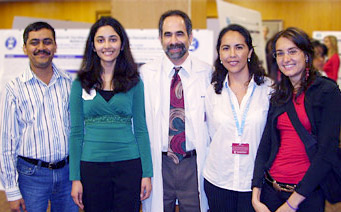Prof. Ronald Lechan
Tufts-New England Medical Center
Double labeling immuno- fluorescence showing association of TRH-containing axons (red) and cocaine-and amphetamine related transcript (CART)-containing axons (green) in the spinal cord of an adult, male, Sprague-Dawley rat. Sections of the spinal cord were incubated in a mixture of rabbit proTRH antiserum and mouse monoclonal CART antibody, followed by incubation in a cocktail of FITC-conjugated anti-mouse IgG and Cy3 conjugated anti-rabbit IgG (Jackson Immunoresearch).
Scale bar = 200 μm.
Research Focus & Application:
We use single-, double-, triple- and quadruple-labeling immunofluorescence to elucidate the anatomical circuitry and mechanisms involved in the regulation of thyrotropin-releasing hormone (TRH)-synthesizing neurons in the hypothalamic paraventricular nucleus (PVN), particularly in association with fasting and infection. Tanycytes are a specialized ependymal cells lining the wall of third ventricle in the mediobasal hypothalamus. They may have a special role in the regulation of hypothalamic-pituitary-thyroid (HPT) axis by producing type 2 iodothyronine deiodinase (D2) and pyroglutamyl peptidase II (PPII) enzymes. We are currently exploring importance of these cells in the feedback regulation of thyroid hormone on hypophysiotropic TRH neurons.
Microscopy and Imaging Methods:
We use brightfield, darkfield, and fluorescence microscopy in combination with in situ hybridization using an Axioplan 2 microscope frequently using 10X-Plan NeoFluar and 20X Plan NeoFluar objectives. ZEISS equipment is used because of its durability/reliability and its ability to generate excellent quality pictures.




